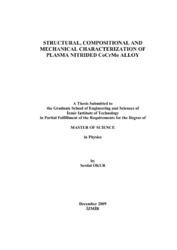Please use this identifier to cite or link to this item:
https://hdl.handle.net/11147/3036Full metadata record
| DC Field | Value | Language |
|---|---|---|
| dc.contributor.advisor | Öztürk, Orhan | - |
| dc.contributor.author | Okur, Serdal | - |
| dc.date.accessioned | 2014-07-22T13:50:45Z | - |
| dc.date.available | 2014-07-22T13:50:45Z | - |
| dc.date.issued | 2009 | - |
| dc.identifier.uri | http://hdl.handle.net/11147/3036 | - |
| dc.description | Thesis (Master)--Izmir Institute of Technology, Physics, Izmir, 2009 | en_US |
| dc.description | Includes bibliographical references (leaves: 103-107) | en_US |
| dc.description | Text in English; Abstract: Turkish and English | en_US |
| dc.description | xv, 107 leaves | en_US |
| dc.description.abstract | Plasma nitriding techniques can be used to create wear and corrosion protective layers on the surface of CoCrMo alloys by modifying the near surface layers of these materials. In the present study, a medical grade CoCrMo alloy was nitrided in a low-pressure ( 60 mTorr) R. F. plasma at 400 Cfor 1, 2, 4, 6, and 20 hours under a gas mixture of 60% N2 . 40% H2. The structural as well as compositional characterization of the plasma nitrided layers were investigated by X-ray diffraction (XRD), scanning electron microscopy (SEM), atomic force microscopy (AFM), and glow discharge optical emission spectroscopy (GDOES). The hardness and wear behaviour of the nitrided layers were performed by a microhardness tester and a pin-on-disk wear apparatus. The experimental analyses indicate that the expanded austenite phase, YN, with high N contents ( 30 at.%) is formed by the plasma nitriding process at 400 C. However, at longer nitriding times (6 and 20 h) there is decomposition into CrN in the YN matrix and a preferential (200) orientation of YN grains parallel to the surface develops. Based on the microscopy analyses of the electrochemically and Ar ion beam etched nitrided sample cross-sections and on the GDOES data, the YN layer thicknessesare found to be ranging from 2 to 10 microns. Based on the thickness data, an average N diffusion coefficient for the CoCrMo samples plasma nitrided at 400 C is estimated to be near 2x10-11 cm2/s. While significant improvements in hardness and wear volume reductions are observed for all the plasma nitrided alloys compared to the untreated alloy, the CoCrMo alloys with the YN structure only had the best combined wear-corrosion protection. | en_US |
| dc.language.iso | en | en_US |
| dc.publisher | Izmir Institute of Technology | en_US |
| dc.rights | info:eu-repo/semantics/openAccess | en_US |
| dc.subject.lcc | QC173.4.S94 .O41 2009 | en |
| dc.subject.lcsh | Corrosion resistant alloys--Testing | en |
| dc.subject.lcsh | Corrosion and anti-corrosives | en |
| dc.subject.lcsh | Surface (Physics) | en |
| dc.subject.lcsh | Nitriding | en |
| dc.subject.lcsh | Molybdenum alloys | en |
| dc.title | Structural, Compositional and Mechanical Characterization of Plasma Nitrided Cocrmo Alloy | en_US |
| dc.type | Master Thesis | en_US |
| dc.institutionauthor | Okur, Serdal | - |
| dc.department | Thesis (Master)--İzmir Institute of Technology, Physics | en_US |
| dc.relation.publicationcategory | Tez | en_US |
| dc.identifier.wosquality | N/A | - |
| dc.identifier.scopusquality | N/A | - |
| item.openairetype | Master Thesis | - |
| item.cerifentitytype | Publications | - |
| item.grantfulltext | open | - |
| item.openairecristype | http://purl.org/coar/resource_type/c_18cf | - |
| item.fulltext | With Fulltext | - |
| item.languageiso639-1 | en | - |
| Appears in Collections: | Master Degree / Yüksek Lisans Tezleri | |
Files in This Item:
| File | Description | Size | Format | |
|---|---|---|---|---|
| T000079.pdf | MasterThesis | 4.22 MB | Adobe PDF |  View/Open |
CORE Recommender
Items in GCRIS Repository are protected by copyright, with all rights reserved, unless otherwise indicated.